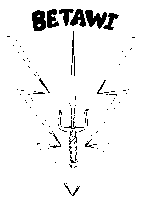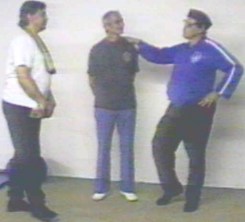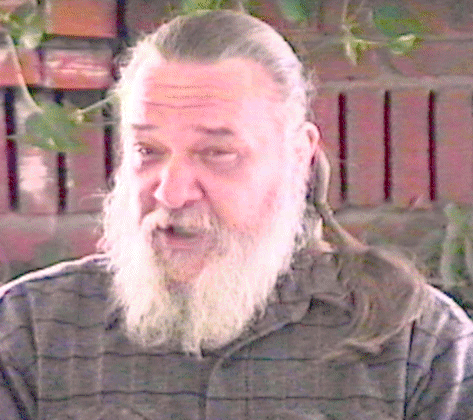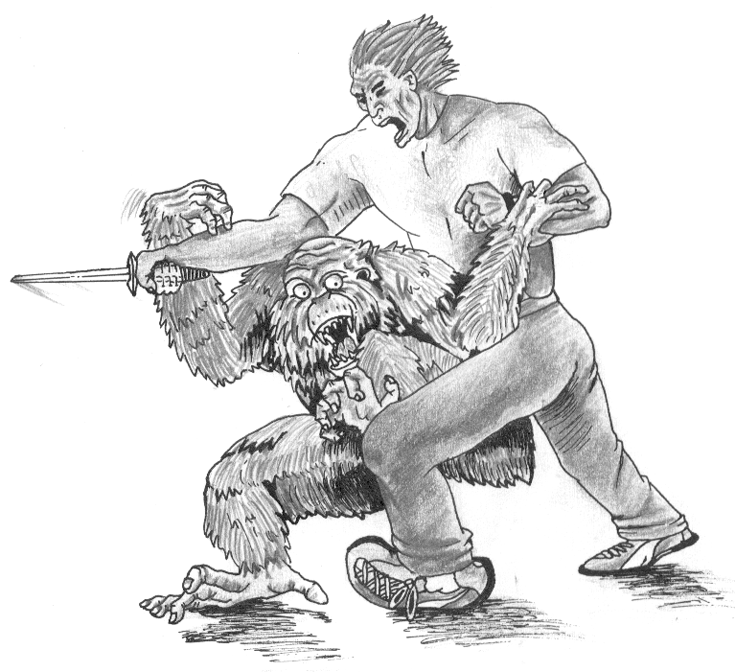
Pukulan Pentjak KunTao Silat Kilap Betawi DeThouars
Copyright 1993 Chas Clements
The KunTao Silat of Betawi Kilap is an art of rich history, deep sophistication and an art of change and adaptation. It is an art formulated to fight with other martial styles, not with untrained opponents. The response to the attack from ambush by multiple armed opponents, the strategies of defense and offense in many different situations and responsibility to the neighborhood community are center to the study of Betawi.
Human history on the Indonesian Archipelago dates to one and one-half million years of continous activity, much of it Martial. The indigenous culture has a continuous social history that rivals Egypt, Rome, Byzantium or South China. They built among the largest buildings in the world, and then they carved pictures all over them about the cultural disciplines that they practiced! The Balinese are among the holiest people in the world, along with the Tibetans and the Irish. It is a spiritual center for humanity.
The Sunda speaking peoples of Sumatra and its attendant islands, especially those of the Bugis tribe, have long been leaders in the practice of martial art in Indonesia. They are of the Menangkebau, the men of the ox-horn, keepers of the Kris. Speaking many languages, they travel broadly 'farming the sea' and trading, while defending their own land from encroachment. Their culture cultivates the portable skills of music, literature, medicine, mechanical engineering and so forth. They are a people of great humor and joy, deep spirituality and culture.
The Empires of the Majapahit, the Suravayjan, the Menangkebau, the Kraton Guards of Jogja, the Sultanates of Atjeh and of Ponti-Anak, have benefitted from the protection of the people of our lineage. The Bugis of the Menangkebau have been artists, statesmen, warriors, explorers and magicians since forever; the De Thouars family is the fruit and flower of that lineage.

Victor - Willem - Paul
Pukulan comes from the word 'Pukul', meaning 'to strike' or 'to collide'- the suffix 'an' connoting a field of study. The word, then, means 'the study of the colliding art'. This usage is primarily Dutch Indonesian. It is roughly equivalent to common handfighting or boxing/wrestling. It also doesn't necessarily have an adherantcy to style lineage as in the idea of a Pusaka (holy legacy/heirloom).
Pentjak (pencak, pentcak, other spellings) denotes the "choreography of movements that are useful in combat". Pentjak may be practiced for its own ends; performance, health, yoga physicality, etc. There is a strong thought that the word has Chinese antecedents as in "pun, cha, te- punch, kick, block". A Dutch Indonesian slang word for all martial arts practitioners is "pentjakkers"(also as in 'karatebrains'). Our pentjak is the flower of our art, in that your personal practice keeps alive the combat technique and reflects it to the descerning eye of your practice leader.
Literally, Silat means 'lightning', the further meaning being 'the combat usages', also, 'the blade'. Silat teaches the methodology of combat application of the Pentjak movements; psychology, tactics and strategy, mental discipline and control. Silat teaches the aspects of the Lightning. Silat is the "buah", the fruit of our practice. Silat cannot be practiced, only experienced; it is your combat experience, refined by study.
Kilap (khilap or kilat) is the Thunder. The aspect of the thunder is the product of the lightning. It teaches a hand of power, striking weak points, crashing and overwhelming the enemy, power in spirit and character. Its' scholarly study is the anatomy of distruction; how to 'break that meat house down'. The study is not so much 'train the frame' as it is 'train the brain'. If mind will lead, body will follow. The study of martial art is not restricted to the athletic of body at all, it is the people of lesser physical presence that need martial art the most.
Betawi (Batavia)is an area on Western Java settled by Sundanese Sumatrans in the
distant past. It is considered a very dangerous place. In addition to identifying the
Sumatran origins of this Silat, it connotes the the study of the techniques of response to
attacks from ambush, fighting multiple opponents- armed as they may come, vicious response
to attack, and a preoccupation with personal freedom and responsibility to the community,
the Family.
The KunTao is reflective of the martial arts practiced by the ethnic Chinese living on Java for more than five hundred years. The Chinese in Indonesia arrived much as the Dutch did; trading, practicing needed professions and crafts, networking into a market for Indonesian products. They were very insular in their culture, they did not marry into the indigineous peoples as the Dutch did, nor teach their professions or crafts. The Indonesians were not permitted to study the Chinese arts (as a general rule).
The original practice in China has been massively modified by the long exposure to the Indonesian concepts of Silat. Honor is given to the Shaolin practices of Honan, Fuchien, Shantung, Kwantung and Fukien, as well as the Three Crowns of TaiChi, PaQua and Hsing-I. The modern,of the last two hundred years, eclectic arts of China combine the 'secrets' of the original arts and add to the knowlege whenever they can, and they had new fields of study in Indonesia.
The Family DeThouars have been nobility in both the West and the East for a long and honourable time. Both of the lineages that meet in the brothers have been prominent and honored in their cultures as educated, artistic, martial in spirit and courageous in action.
The European family of Holland and Northern France have been the nobility of Tours for hundreds of years, constructing the cutlery and armaments factories for which they are so famous. They owned their own farms, mines, factories and craftsmen, ships and crews, traders and businessmen. The DeThouars family were swordsmen and horsemen, colonels of the military and advisers to the King.
The Indonesian forebearers have been nobles, landowners and confidants of Sultans while maintaining a family system of Silat that has made them champions to all comers for over one-hundred fifty years. They were village elders, chiefs and leaders, landowners, merchants and warriors. They met the Dutch as equals; they were never conquered, not to this day.
The Pendekar Agung, Raden
Mas Paul DeThouars, is an undefeated champion on the kendang, the formal challenge floor. His
guidance and leadership of the holy pusaka legacy of Serak Tulen has always been to the
honour of those that entrusted it to him. He is the first and most senior of all Silat in
America, having given the U.S. a continuous teaching and guidance for over thirty-five
years-unchallenged by any.
formal challenge floor. His
guidance and leadership of the holy pusaka legacy of Serak Tulen has always been to the
honour of those that entrusted it to him. He is the first and most senior of all Silat in
America, having given the U.S. a continuous teaching and guidance for over thirty-five
years-unchallenged by any.
The Guru Besar, Hai-Teng Sifu Willem DeThouars has given his life to two things; his family-his Art. In his expression of his love of Him, Uncle Bill has gone into the world- to study, to learn and compare and challenge and sustain. His humble compassion comes from a lifetime of adversity, his teaching from a lifetime of study and practice, and his punch, I understand, from his Grandfather.
Pendekar Bapak Victor DeThouars is the sustenance of Serak, and the Founder of Tongkat. As he proceeds into his life of service to the family, he conserves the body of knowlege. He will, in the fullness of time, be the Pendekar of Serak. His practice and teaching is a gift to be a part of, all of his students are appreciative of that.
Guru Chas
Clements has been privileged to study with three of the brothers
DeThouars, holding certification in KunTao Silat and Pentjak Silat. Commencing in 1978,
his association with the family has been ongoing. Prior to his entry into the Pukulan
association, his background in martial art dates to 1953. 
Silat Kilap Betawi is practiced under the guidance of the family DeThouars; hormat is given to the family and to the tulen legacy and lineage of Pak Serak and Mas Djoet, and the lineage of the KunTao that results in the art of the Ratu Duri of the KunLunPai. Honour is given for the gifts of all the teachers and practitioners who have contributed to the state of this art.
The Kendang Silat, from which these expressions derive, is a traditional fighting art of Western Java. The Kendang is the great drum of the Gamelan orchestra, the word also applies to the fighting floor, and to the region of the Gunung Kendang ('Drum Mountain') range, from whence come the Bugis people of the Menangkebau Sumatran forebears. This is the arena of the 'drum fighters' style. Aspects of the style derive from the Indian influence, the Muslims, the Chinese, the Europeans and the indigenous arts of the animist magicians. Our art is formulated to defend against other martial arts, including those unknown to us.
The Champion defending comes to the floor and dances with his female partner an intricate demanding dance, joined by the holding of a scarf. The dance shows footwork with a partner, passages of hand and the use of rhythm, then he performs his 'kambangan'. This 'flower dance' is his expression of pencak, free-form, to the music of the gamelan. The 'flower' (kambang)of a style is its' performance form, the 'fruit' (buah) of a style is its' combat expression to an actual enemy- there is no 'sporting' or 'sparring' application. He challenges: "Kitai Brani?"-Who has the guts to fight? The answer comes from the challenger: "Shiapa Brani"- I have the guts to fight!
The challenger; having seen the footwork, practice patterns and physical expression of the Champion, and being Champion of another village and style, feels that his style will prevail. The pair meet on the floor and try to sweep one another with the foot, keeping the hands behind them. This is a very legitimate test of combat capability, testing footwork, timing and intention. The loser of this contest has the option of retiring from the floor or continuing the contest, unfettered, to the major maiming or death. All contestants are required to bring to the contest a packet of sweet herbs, a sheet to wrap his corpse and transportation money back home. Kendang Silat is an art with which to fight other arts, a battlefield art with which to fight for the village.
The Serak is the legacy of Pak Serak. Born in Sumatra in 1790, of the Bugis people, he was a one-armed, club-footed practitioner. Nicknamed Burung Serak,'Owl', for his clairvoyant powers and spiritual being - this in a culture of very spiritual people known as the 'Invisible people of the Mountain Forest'. He studied nine separate martial arts; 4 Indonesian, 3 Chinese and 2 Indian, felt himself proficient in three, utilizing them to lead as the Champion, undefeated in his time. He traveled very widely as a bodyguard and later as a teacher and a political activist. His synthesis of the stylings and diverse technique of nine studies and the unique view of a physically challenged practitioner gave him an art with which to fight other arts. He, and his senior student Mas Djoet, formalized the art Serak and it has been passed down unchanged, given by all the status of Pusaka- a holy legacy.
The Kuntao Silat of Ratu Duri is an expression of the mastery of a number of styles and influences. The western Java arts of Pamor, Kwitang, Tjimande- the Quemoy Kuntao- pakua chang- hsing po- tai kek, western boxing and the art of Legrands' combat fencing, and others, have, in the person of Uncle Bill, built on the early teachings of the family elders. It is an art of change, synthesis and adaptation. It is responsive to the needs of the practitioner; his body, attitude, convenience, spirituality. The Hai-Teng Sifu Willem DeThouars has crystallized the Ratu Duri,"Thorny King", techniques out of the crucible of fifty years of concentrated intention and study of the most difficult arts in the most dangerous places in the world.
The physical art of Pukulan Pentjak KunTao Silat Kilap Betawi is secondary to the intellectual and spiritual teaching embodied therein. Our first reverence is for God, the only Master. Our lives in the world must reflect the discipline and teachings of the art. Our practice of the art is for its' own sake. The gifts that the art has to give are far past just the fighting aspect. The tactics and strategies taught in the art give power and success in all facets of ones' life.
The symbol of the Kilap Betawi is two lightning flashes of three parts each, arranged as a triangle, the siku-siku in the center, all arranged within a triangle and the words Silat Kilap Betawi on the sides. The repetition of the tiga reflects the grouping of the knowlege and is used as a mnemonic to facilitate remembering difficult material. The siku-siku, center weapon of the style, is indicative of the armed aspect of the art, we are not foolish enough to assault anyone without bringing tools. It is a three weapon- parts, uses, symbolic aspect. It honours the arts Serak, Ratu Duri, Bukti Negara/Tongkat and the three brothers that have given us the honour of practicing in their presence.
Another aspect of the art is the personal loyalty and group identity, 'pai', fostered by the intimacy of the teachings. A 'pai' is translated from the Chinese as 'animal hand' as opposed to 'chuan', a human fist. A pai is idiomatically, ' a group of men going about doing honorable work', the fingers of the pai are individual, they support and form the 'hand'. It also connotes the utilization of the animal ideoform to teach martial precepts, techniques and attitudes. The KunLun Pai is the 'animal hand of the fighters of KunLun' (a mountainous region of Hokkien, well known for political activism and advanced combat practitioners).
Silat Betawi is taught as a 'beladiri' a personal defense art, rather than a 'pusaka' or formal legacy art. As there is no sparring aspect to the art, all techniques are learned by one practitioner submitting to the technique of the training partner. This submission can test the trust of the partner as all techniques are viciously invasive. To deal with the most interior of emotions and philosophies is the nature of the practice of martial art, to let a stranger into that intimacy is another matter.
Many of the techniques and applications of the art come from the morality of another culture not our own, their application is a matter for philosophical exploration in the context of study and intellectual expansion. The questions stem from the focus of the art which is death, pain, ambush, mayhem, subterfuge
The art is presented as a cultural artifact of scholarly interest, and any participant is enjoined to pick and choose those aspects to which his life experience is responsive. The art and its practitioners also choose with whom they will share their lives.
Chas Clements 303-364-0403